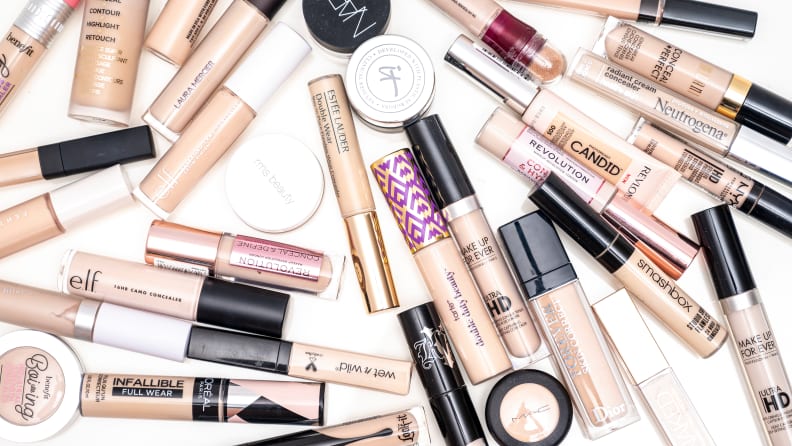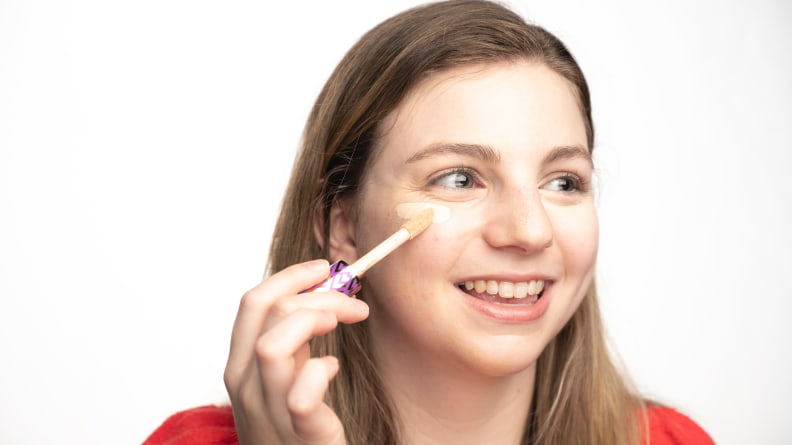Products are chosen independently by our editors. Purchases made through our links may earn us a commission.
There’s no denying that makeup application has been elevated to an art form. Whether you’re trying to perfect a smokey eye or you prefer an easy five-minute face, you want to get the motions down to replicate your favorite look over and over. One of those requisite basics is concealer, as it’s used for everything from covering up a rogue pimple to diminishing dark under-eye circles to create a blank canvas. And the interesting thing about concealer is that opinions on the application and best practices vary widely.
To help you master concealer application, we spoke to celebrity makeup artist Scott Barnes, who has worked with the likes of Jennifer Lopez, Beyonce, and Gwen Stefani. These are the eight common mistakes he says you should avoid—and how to fix them.
1. The wrong shade: How to pick a concealer for your skin tone
The biggest mistake people make is using the wrong shade of concealer, often opting for one that’s too light. Using a shade that’s too light (under the eyes, for example) “gives a flashback effect and makes the area underneath your eyes appear unnaturally white in photos,” Barnes says. Generally, you want one shade lighter than your skin tone for all-purpose concealing. The lighter concealer color will actually look more natural when paired with your foundation, as it mimics the natural highlights and shadows that the light casts on your face. You can also opt for twoshades lighter than your natural skin tone if you really want to brighten up the area, but any lighter than that and you’ll end up highlighting your imperfections instead of concealing them.
If you’re unsure how to choose a lighter shade that’ll look natural on you, find a concealer that matches your skin color and undertones, then move up to the next lightest shade that has those same undertones. For example, our lifestyle writer, Jessica Kasparian, wears the shade “Fair Neutral” in our Best Overall Tarte Shape Tape Concealer because her skin best resembles “Fair-Light Neutral.”
2. The wrong formula: How to pick concealer for your skin type

With many concealers to choose from, look for ones that claim to work for your skin type (dry, normal, or oily).
Another common mistake is using the wrong formula for your skin type. Pay attention to your skin type and shop for concealers accordingly. If you have dry skin, look for a formula that claims to be hydrating or that has a dewy, satin finish. If your skin leans oily, aim for a concealer that touts a mattifying or oil-absorbing finish.
3. Too many shades: How to pick concealer for highlighting
For those who want to add depth to the face, it's common practice to use more than one shade: one to match the face and one to brighten. But this is overkill for most people. “One concealer is usually fine to use on the entire face,” says Barnes. For best practice, stick with our advice to choose a concealer color that's one shade lighter than your skin tone. If you want a more obvious brightening effect, Barnes says you can opt for a color that's two shades lighter than your skin tone instead.
4. The wrong order: Apply concealer before foundation
This particular aspect of concealer application is a source of controversy. Every make-up artist has their own approach, but some say that concealer should be applied after foundation because, otherwise, you’ll just end up wiping it off as you blend your foundation. Not to mention that, when you apply concealer after your foundation, you’ll use less product and avoid looking cakey and overdone.
However, Barnes is on team concealer first: “I have always found it to be important to first put down the structure of the face with concealer and contouring before laying down foundation. This way, you get lightness and brightness, as well as the ‘structure’ in the correct places underneath before placing foundation on top. You then use the foundation on top to blend it together for a flawless and natural-looking effect.”
If you don’t usually contour or if you only use a dab of concealer under each eye or on spots, this may not be a defining step, but it’s worth a try to follow this expert advice.
5. Missing strategic spots: Where to put concealer
While applying concealer to the under-eye area seems like a no-brainer, most folks seem to forget about a few other strategic spots: the eyelids and lips. Applying concealer to these areas primes them for color application and helps your color adhere better than it would on bare skin. And it’s more efficient than grabbing a separate primer product, which basically does the same thing. Moreover, applying concealer on your lids and lips helps to neutralize any discoloration (like veining on the eyelids) and undertones. When your eyeshadow and lip color don’t have to battle your skin’s natural tones for supremacy, the result is eye-popping color.
6. The wrong technique: How to put on concealer for maximum coverage
This might come as a surprise for some, but you need to be a bit strategic to hide dark circles effectively when you’re applying concealer. Instead of looking at the mirror straight on, tilt your head downward (dropping your chin toward your chest), so you can see where your under-eye shadows fall. The deepest parts of the shadow are where your concealer should be applied.
7. Too much product: How to put on concealer for natural results

For natural results, start with a small amount of concealer and build up coverage slowly.
If you’re going for a natural look, remember that less is more. “People tend to use too much product, which can cause unnecessary creasing,” Barnes says.
Even with blemishes, you want to take care and use it sparingly, as too much concealer may amplify blemishes and make them look more noticeable. Start with just a dab of concealer at first and look at it at a glance with the rest of your face to make sure it’s blending well. You can always go back and layer on more for extra coverage.
8. The wrong tools: What to apply concealer with
Blending is one of the most important steps to master when applying concealer. Too much blending makes the product disappear, resulting in lost time—and money. Not enough blending leaves the product visible, which is presumably not the look you’re going for.
But the jury is still out on the best tools for applying concealer. Some say fingertips suffice for the under-eye area, as the warmth of your finger keeps the product more malleable. Others swear by foam sponges, like the Beauty Blender.
To get a flawless blend, Barnes nixes both of those. “For the best control and smoothest application, I prefer to use brushes for applying everything, including foundation and concealer, says Barnes. “I use a flat foundation brush under the eye for initial application and blending of concealer.” Barnes notes that, with brushes, he has greater control over how much product he uses, and they lend to a smoother application—something that fingers and sponges just can’t do.
The product experts at Reviewed have all your shopping needs covered. Follow Reviewed on Facebook, Twitter, and Instagram for the latest deals, product reviews, and more.


